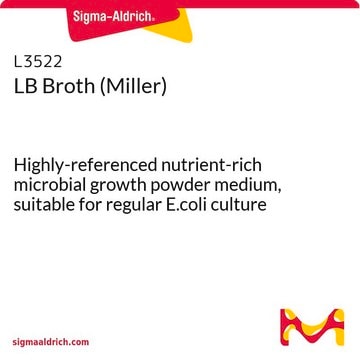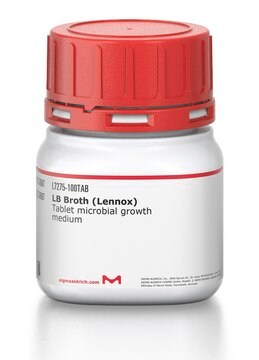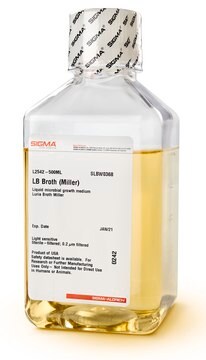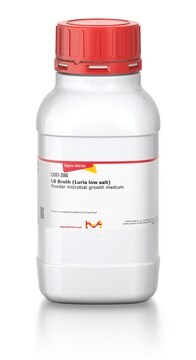L7658
LB Broth (Lennox)
EZMix powder microbial growth medium
Sinonimo/i:
Lennox broth
About This Item
Prodotti consigliati
Grado
for molecular biology
Livello qualitativo
Descrizione
quick-dissolve, dust-free formulation
Sterilità
non-sterile
Forma fisica
powder
tecniche
microbiological culture: suitable
pH
6.8-7.2(2.5% solution)
applicazioni
agriculture
food and beverages
microbiology
Temperatura di conservazione
room temp
Compatibilità
nonselective for Escherichia coli
nonselective for coliforms
Descrizione generale
Applicazioni
Caratteristiche e vantaggi
- Granulated, dust-free format for safer handling and faster mixing
- Convenient small package to eliminate weighing
- Easy scale-up using larger package sizes
- Standard formulation
Componenti
10g/L Tryptone
5 g/L Yeast Extract
5 g/L NaCl
0.6 g/L inert binder (EZMix formulation only)
Nota sulla preparazione
2. Autoclave for 15 minutes at 121 °C.
To prepare Lennox L Broth: Add 1 g glucose and proceed with preparation instructions as above.
To prepare the medium of Enquist and Sternberg: Aseptically add 10 ml of sterile 1M magnesium sulfate after autoclaving.
Ricostituzione
Note legali
Prodotti correlati
Codice della classe di stoccaggio
11 - Combustible Solids
Classe di pericolosità dell'acqua (WGK)
WGK 2
Punto d’infiammabilità (°F)
Not applicable
Punto d’infiammabilità (°C)
Not applicable
Certificati d'analisi (COA)
Cerca il Certificati d'analisi (COA) digitando il numero di lotto/batch corrispondente. I numeri di lotto o di batch sono stampati sull'etichetta dei prodotti dopo la parola ‘Lotto’ o ‘Batch’.
Possiedi già questo prodotto?
I documenti relativi ai prodotti acquistati recentemente sono disponibili nell’Archivio dei documenti.
Il team dei nostri ricercatori vanta grande esperienza in tutte le aree della ricerca quali Life Science, scienza dei materiali, sintesi chimica, cromatografia, discipline analitiche, ecc..
Contatta l'Assistenza Tecnica.







